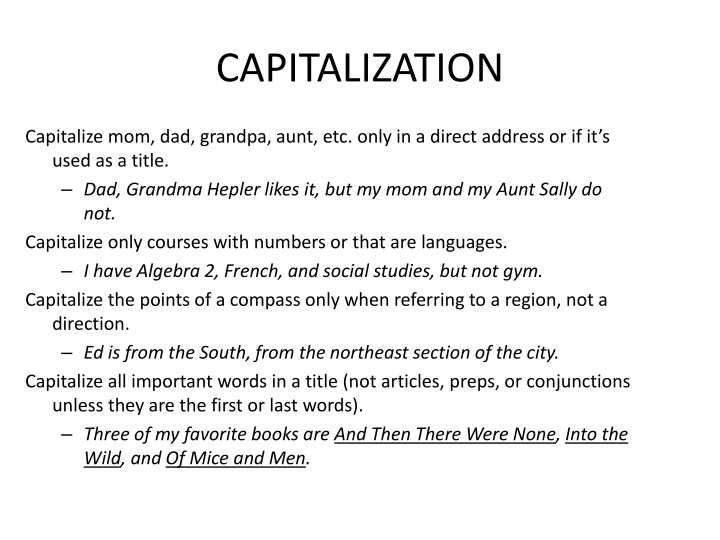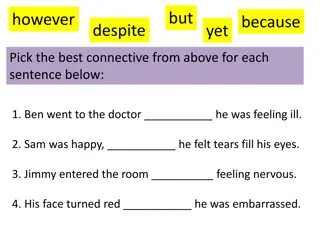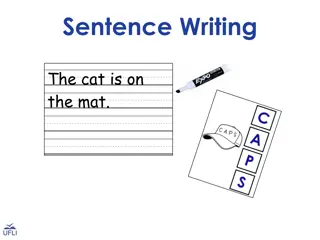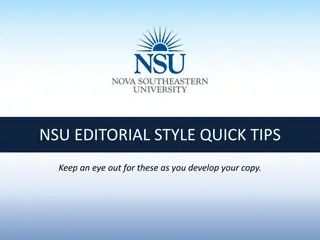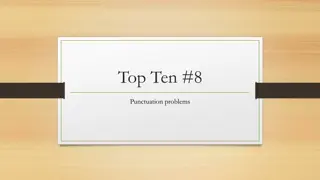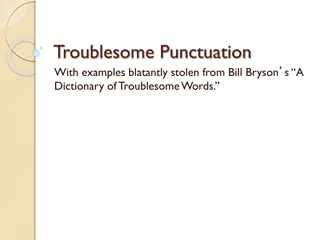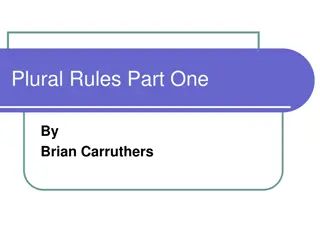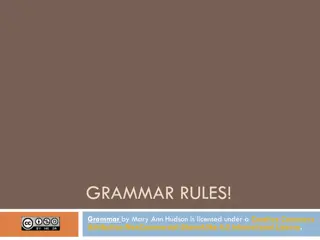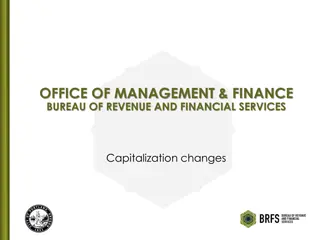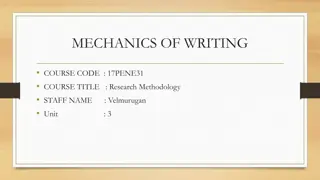Grammar Rules Guide: Capitalization, Possessives, and Plurals
Learn the rules of capitalization, possessives, and forming plurals in English grammar. Understand when to capitalize titles, direct addresses, and regions. Discover how to form possessives for singular, plural, and irregular nouns. Get insights on creating plural forms, especially for compound words and Latin terms. Explore examples and guidelines for mastering these essential grammar concepts.
Download Presentation

Please find below an Image/Link to download the presentation.
The content on the website is provided AS IS for your information and personal use only. It may not be sold, licensed, or shared on other websites without obtaining consent from the author.If you encounter any issues during the download, it is possible that the publisher has removed the file from their server.
You are allowed to download the files provided on this website for personal or commercial use, subject to the condition that they are used lawfully. All files are the property of their respective owners.
The content on the website is provided AS IS for your information and personal use only. It may not be sold, licensed, or shared on other websites without obtaining consent from the author.
E N D
Presentation Transcript
CAPITALIZATION Capitalize mom, dad, grandpa, aunt, etc. only in a direct address or if it s used as a title. Dad, Grandma Hepler likes it, but my mom and my Aunt Sally do not. Capitalize only courses with numbers or that are languages. I have Algebra 2, French, and social studies, but not gym. Capitalize the points of a compass only when referring to a region, not a direction. Ed is from the South, from the northeast section of the city. Capitalize all important words in a title (not articles, preps, or conjunctions unless they are the first or last words). Three of my favorite books are And Then There Were None, Into the Wild, and Of Mice and Men.
POSSESSIVES If the word is singular add s regardless of how it ends. If the words is plural and end is s simply add . If the word is plural and doesn t end in s (called irregulars) add s. When making two (or more) possessives @ once, you only need to make the last possessive.
Plurals elementary school *To form the plural of most nouns, just add s *When a singular noun ends in s, sh, ch, x, or z, you add es . *When the singular noun ends in consonant y, you change the y to i and add ies . When it s vowel -y, just add s . *When a singular noun ends in o, you add s or es . *For most nouns ending in f or fe, change the f to v and add s or es . Of course there are always words that follow no pattern. We refer to these as irregulars.
PLURALS grade level *To form the plural of a compound noun written as one word, change the last word in the compound to its plural form. Otherwise change the most important word to the plural form. *For some unique Latin words, they follow a traditional Latin pattern. If a Latin word ends in a, change it to ae . If a word ends in us, change it to i. A lesser known rule is that apostrophes can pluralize non-words - Non-words refers to letters, numbers, symbols, and words that need help to pluralize.
PLURALS grade level examples Ex. snowman becomes snowmen brother-in-law becomes brothers-in-law Ex. alumnus becomes alumni fungus becomes fungi Ex. She earned three A s and two B s on her report card. I have no 5 s in my phone number, but I do have a couple 2 s. I get tired of seeing & s used in place of the word and. No if s, and s, or but s about it, I am going to win! ***In the ultra rare case, if I need to make one of these plurals possessive, still only use one apostrophe. Ex. The two s circumferences were a total of 3.5 feet.
TOP 10 #9 key Possessives A 1. bicyclist s 2. students 3. year s 4. tree s 5. Dennis s 6. bus s 7. oxen s 8. writers 9. sheep s 10. minibike s Possessives A Possessives B 1. boy s mother 2. winners exhibits 3. gentlemen s gloves 4. Galileo s discover 5. Miss Thomas s explanation 6. monkeys cages 7. wineglass s stem 8. year s end 9. knights lances 10. travelers rest stop 11. lawyers 12. Los Angeles s 13. The Jacksons 14. lady s 15. group s 16. knives 17. sailors 18. teacher s 19. library s 20. children s
Top 10 #9 key 18. banjos (or banjoes) 19. brushes 20. staffs (also staves music, staff - teachers) 21. dresses 22. knives 23. heroes (or heros the sandwich) 24. flies 25. tomatoes 26. dwarfs (or dwarves) 27. sons-in-law 28. teeth 29. pushups 30. enemies 31. cattle 32. thieves 33. children 1. elephants 2. ladies 3. snowmen 4. monkeys 5. footsteps 6. cameos 7. moose 8. fish (or fishes) 9. glasses 10. roofs 12. raspberries 13.toys 14. lives 15. bunches 16. boxes
ESSENTIAL KNOWLEDGE #9 As Brian Regan suggests these rules are complex, random, and ultimately, problematic. Thus, pay attention, absorb, and memorize (and thank the heavens for spell check). ***While the world will not end if you incorrectly capitalize algebra, DO NOT CONFUSE making words plural with making them possessive dog baby vs. dogs vs. babies vs. dog s vs. baby s vs. dogs vs. babies
Singular noun Plural noun Singular possessive Plural possessive $ 7 Alumna (Latin) Alumnus (Latin) Attorney General Spirit Day Glass* Pistachio* Radio* Toothpaste* Ox* Venom* Goose* Mouse* Thief* Staff*
Singular noun Plural noun Singular possessive Plural possessive Cherry Box Deer* Father-in-law Value meal Sport Basketball hoop Trio* Domino* Tooth* Foot* Class Phone Butterfly Syllabus (Greek) Flower
